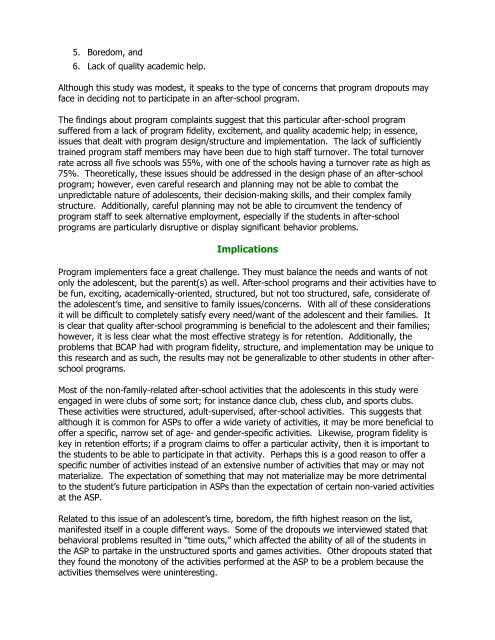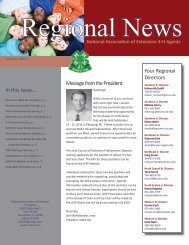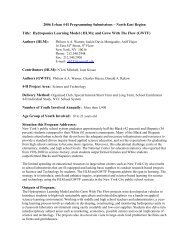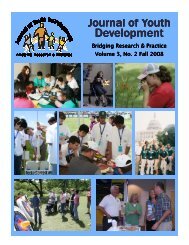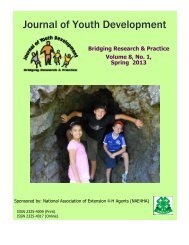Winter 2008 - Vol. 3 No. 3 - National Association of Extension 4-H ...
Winter 2008 - Vol. 3 No. 3 - National Association of Extension 4-H ...
Winter 2008 - Vol. 3 No. 3 - National Association of Extension 4-H ...
- No tags were found...
Create successful ePaper yourself
Turn your PDF publications into a flip-book with our unique Google optimized e-Paper software.
5. Boredom, and6. Lack <strong>of</strong> quality academic help.Although this study was modest, it speaks to the type <strong>of</strong> concerns that program dropouts mayface in deciding not to participate in an after-school program.The findings about program complaints suggest that this particular after-school programsuffered from a lack <strong>of</strong> program fidelity, excitement, and quality academic help; in essence,issues that dealt with program design/structure and implementation. The lack <strong>of</strong> sufficientlytrained program staff members may have been due to high staff turnover. The total turnoverrate across all five schools was 55%, with one <strong>of</strong> the schools having a turnover rate as high as75%. Theoretically, these issues should be addressed in the design phase <strong>of</strong> an after-schoolprogram; however, even careful research and planning may not be able to combat theunpredictable nature <strong>of</strong> adolescents, their decision-making skills, and their complex familystructure. Additionally, careful planning may not be able to circumvent the tendency <strong>of</strong>program staff to seek alternative employment, especially if the students in after-schoolprograms are particularly disruptive or display significant behavior problems.ImplicationsProgram implementers face a great challenge. They must balance the needs and wants <strong>of</strong> notonly the adolescent, but the parent(s) as well. After-school programs and their activities have tobe fun, exciting, academically-oriented, structured, but not too structured, safe, considerate <strong>of</strong>the adolescent’s time, and sensitive to family issues/concerns. With all <strong>of</strong> these considerationsit will be difficult to completely satisfy every need/want <strong>of</strong> the adolescent and their families. Itis clear that quality after-school programming is beneficial to the adolescent and their families;however, it is less clear what the most effective strategy is for retention. Additionally, theproblems that BCAP had with program fidelity, structure, and implementation may be unique tothis research and as such, the results may not be generalizable to other students in other afterschoolprograms.Most <strong>of</strong> the non-family-related after-school activities that the adolescents in this study wereengaged in were clubs <strong>of</strong> some sort; for instance dance club, chess club, and sports clubs.These activities were structured, adult-supervised, after-school activities. This suggests thatalthough it is common for ASPs to <strong>of</strong>fer a wide variety <strong>of</strong> activities, it may be more beneficial to<strong>of</strong>fer a specific, narrow set <strong>of</strong> age- and gender-specific activities. Likewise, program fidelity iskey in retention efforts; if a program claims to <strong>of</strong>fer a particular activity, then it is important tothe students to be able to participate in that activity. Perhaps this is a good reason to <strong>of</strong>fer aspecific number <strong>of</strong> activities instead <strong>of</strong> an extensive number <strong>of</strong> activities that may or may notmaterialize. The expectation <strong>of</strong> something that may not materialize may be more detrimentalto the student’s future participation in ASPs than the expectation <strong>of</strong> certain non-varied activitiesat the ASP.Related to this issue <strong>of</strong> an adolescent’s time, boredom, the fifth highest reason on the list,manifested itself in a couple different ways. Some <strong>of</strong> the dropouts we interviewed stated thatbehavioral problems resulted in “time outs,” which affected the ability <strong>of</strong> all <strong>of</strong> the students inthe ASP to partake in the unstructured sports and games activities. Other dropouts stated thatthey found the monotony <strong>of</strong> the activities performed at the ASP to be a problem because theactivities themselves were uninteresting.


